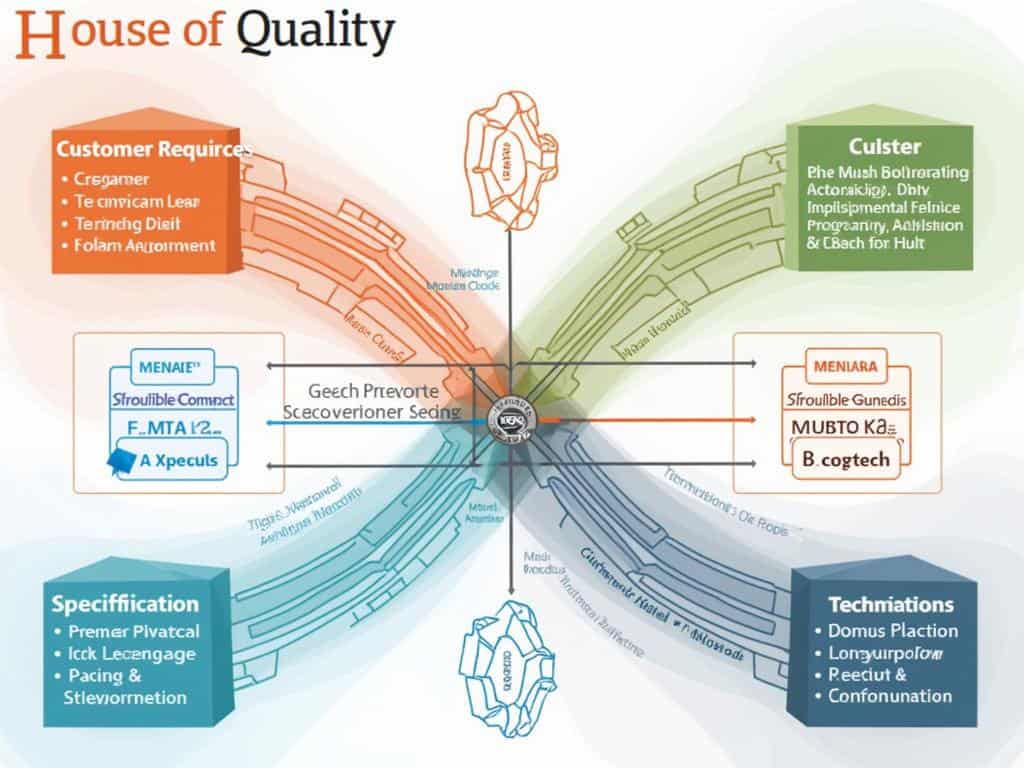
Understanding QFD Quality and Its Impact on Product Development
QFD Quality transforms customer insights into design excellence by providing a systematic methodology that bridges the gap between customer requirements and technical specifications. By implementing Quality Function Deployment, organizations can create products that precisely align with customer needs, ensuring a comprehensive and customer-centric approach to product development.
Key Takeaways
- QFD quality methodology systematically translates customer requirements into actionable design specifications.
- The House of Quality matrix serves as a central tool for mapping customer needs to technical parameters.
- Cross-functional collaboration is essential for successful QFD quality implementation.
- Competitive benchmarking and risk analysis are integral to the detailed design process.
- Organizations can achieve significant improvements in development time, engineering changes, and customer satisfaction through QFD quality approaches.
Quality Function Deployment stands as a powerful method for translating customer voices into technical requirements. This structured approach helps you capture what customers actually want and convert those needs into specific engineering characteristics. The QFD process dramatically reduces development cycles while improving product quality.
The House of Quality Matrix
The House of Quality matrix forms the cornerstone of effective QFD implementation. This visual tool connects customer priorities with corresponding technical specifications, creating clear relationships between what customers value and how your organization can deliver it. Teams use this matrix to identify critical design parameters that directly impact customer satisfaction.
The Role of Cross-Functional Teams
Cross-functional teams play a crucial role in QFD success. By bringing together expertise from marketing, engineering, manufacturing, and quality assurance, you’ll gain comprehensive insights that lead to better decisions. These diverse perspectives ensure all aspects of product development align with customer expectations.
Competitive Analysis in QFD
Competitive analysis adds another dimension to the QFD methodology. By evaluating how your products compare to competitors across key customer requirements, you’ll spot opportunities for differentiation. This competitive benchmarking helps prioritize development efforts where they’ll create the most market advantage.
Technical Correlations and the Roof Matrix
Technical correlations identify potential conflicts between design parameters. The roof matrix portion of the House of Quality highlights where improvements in one area might negatively impact another, allowing for early resolution of these trade-offs. This analysis prevents costly redesigns later in development.
Risk Assessment and Resource Allocation
Risk assessment becomes straightforward with QFD techniques. By evaluating the difficulty of meeting technical targets against their importance to customers, you can allocate resources effectively. This targeted approach focuses efforts on high-impact features that matter most to users.
Benefits of Implementing QFD
Organizations implementing QFD consistently report significant benefits. These include 30-50% reductions in development time, 20-60% fewer engineering changes, and substantial improvements in customer satisfaction. The systematic approach ensures products meet or exceed customer expectations.
The Importance of Documentation
Documentation of decisions creates valuable organizational knowledge. The QFD process captures the reasoning behind design choices, creating a record that informs future product iterations. This institutional memory proves invaluable as teams change and products evolve.
Emerging Customer-Focused Metrics
Customer-focused metrics emerge naturally from the QFD methodology. Rather than relying solely on internal specifications, you’ll develop performance indicators that directly connect to customer requirements. These metrics keep development aligned with what truly matters to users.
“Quality Function Deployment transforms customer insights into actionable design, forging a vital connection between needs and specifications. By fostering cross-functional collaboration and leveraging tools like the House of Quality, organizations can enhance their products, streamline development, and elevate customer satisfaction to new heights.”
Voice of the Customer: The Foundation of QFD
The Voice of the Customer (VOC) forms the essential starting point of QFD quality implementation. You’ll find that successful product development begins with understanding what your customers truly want and need. QFD quality methodology transforms these customer insights into actionable design specifications that drive excellence throughout the development process.
Collecting customer feedback systematically ensures your QFD quality process remains grounded in real-world needs. You can gather these insights through multiple channels:
- Customer surveys that quantify preferences and satisfaction levels
- In-depth interviews to uncover detailed requirements and pain points
- Focused group discussions that reveal collective perspectives
- Analysis of customer complaints to identify improvement opportunities
When implementing QFD quality practices, you’ll benefit from integrating the Kano Model to categorize customer requirements effectively. This framework helps you distinguish between three critical types of needs:
- Basic needs (“musts”) – fundamental requirements that cause dissatisfaction when absent
- Performance needs (“wants”) – features that increase satisfaction proportionally to their presence
- Delighter features (“wows”) – unexpected elements that significantly boost satisfaction
Prioritizing these customer requirements represents a crucial step in the QFD quality process. You need to determine which needs carry the most weight in ensuring stakeholder satisfaction before proceeding to technical specifications.
The table below shows how QFD quality implementation transforms customer feedback into development priorities:
| Customer Feedback Type | QFD Quality Integration | Business Impact |
|---|---|---|
| Explicit requirements | Direct specification mapping | Meets basic expectations |
| Implied needs | Translated into technical parameters | Addresses unspoken desires |
| Future expectations | Innovation opportunities | Creates competitive advantage |
By establishing a structured approach to capturing customer voices, you create a solid foundation for the entire QFD quality deployment process. This customer-centric starting point ensures that project integration management remains focused on delivering genuine value rather than assumed benefits.
Remember that QFD quality implementation success depends on how effectively you transform these customer insights into clear specifications. The systematic collection and analysis of VOC data prevents subjective interpretations and guides your development team toward truly customer-focused solutions.

House of Quality: Mapping Customer Needs to Technical Specifications
The House of Quality (HOQ) serves as the central matrix tool in QFD quality methodology, creating a visual framework that transforms customer requirements into actionable technical specifications. You’ll find this powerful technique helps your development team maintain focus on what truly matters to customers while ensuring engineering efforts align with market demands.
HOQ creates structured relationships between what customers want and how your team will deliver it. This systematic approach prevents costly design errors by ensuring QFD quality principles are embedded from the earliest development stages.
The matrix consists of several interconnected rooms that form the “house” structure:
- Customer requirements (the “what” – left side)
- Technical specifications (the “how” – top section)
- Relationship matrix (center section)
- Correlation matrix (roof section)
- Competitive assessment (right side)
- Prioritization and targets (bottom section)
When implementing HOQ, you’ll start by listing customer requirements gathered through active listening techniques and research. Each requirement receives an importance rating based on customer feedback. This voice of the customer forms the foundation of QFD quality implementation.
Creating Effective Technical Specifications
The technical specifications section translates customer language into engineering characteristics. Your team must identify measurable parameters that address each customer need while maintaining QFD quality standards. This translation process helps project leaders ensure nothing gets lost between customer expectations and technical delivery.
The relationship matrix shows connections between requirements and specifications with symbols indicating strong, moderate, or weak relationships. This visual representation helps identify gaps where customer needs lack technical solutions – a critical QFD quality check.
| Symbol | Relationship | Value |
|---|---|---|
| ● | Strong | 9 |
| ○ | Moderate | 3 |
| △ | Weak | 1 |
| (blank) | None | 0 |
The correlation matrix (roof) shows how technical specifications influence each other, helping identify trade-offs and synergies. This aspect of QFD quality methodology prevents contradictory design decisions and enhances continuous improvement opportunities.
When properly implemented, the House of Quality transforms abstract customer wishes into concrete design specifications, ensuring your product development maintains QFD quality throughout the process. By systematically connecting customer requirements to technical solutions, you’ll deliver products that truly satisfy market needs while optimizing development resources.
Expert Insight: Utilize the House of Quality (HOQ) matrix to effectively align customer needs with technical specifications, ensuring that your development team remains customer-focused while adhering to market demands. By systematically mapping customer requirements to measurable engineering parameters, you can identify gaps and enhance collaboration, ultimately preventing costly design errors. Implementing HOQ early in the design process cultivates a shared understanding of priorities, leading to products that exceed customer expectations and optimize resource utilization.
Detailed Design and Development Process
The detailed design phase transforms customer requirements into specific design parameters using QFD quality methodology. This critical stage ensures that every customer need is properly addressed in the final product specifications. During this phase, you’ll see customer requirements cascade into increasingly detailed design elements.
Cross-functional teams collaborate to translate high-level specifications into actionable engineering requirements. This collaboration helps identify critical parts and assemblies that will determine product performance. QFD quality principles guide teams in establishing clear priorities based on customer importance ratings and technical feasibility.
Risk analysis becomes integral during detailed design, allowing teams to anticipate potential failure modes. You’ll find that effective risk response planning during this stage prevents costly modifications later. The QFD quality approach ensures preventive measures are built into the design rather than discovered during testing.
Competitive Benchmarking Integration
Competitive benchmarking serves as a vital component of the detailed design process. By analyzing competitors’ products, you can identify:
- Performance gaps that present opportunities for innovation
- Industry standards that must be met or exceeded
- Unique selling propositions that differentiate your product
- Technical approaches that may inspire design solutions
- Cost-performance tradeoffs made by competitors
This benchmarking data helps prioritize design efforts on features with the greatest competitive advantage. The QFD quality process uses this information to establish performance targets for each specification. Your strategic planning efforts benefit from this competitive context, ensuring resources focus on truly differentiating features.
During detailed design, teams regularly revisit the House of Quality matrix to verify alignment with original customer requirements. This continuous validation prevents scope creep and maintains focus on QFD quality objectives. The process creates a transparent link between customer needs and specific design decisions, facilitating clear communication across departments.
Technical parameter establishment follows, with detailed specifications for each component. These specifications include materials, dimensions, tolerances, and performance characteristics. Each specification directly links to customer requirements through the QFD quality relationship matrices, ensuring nothing important gets overlooked during development.
Organizations that excel in product design are 50% more likely to achieve high customer satisfaction and loyalty compared to their peers.
hbr.org
Manufacturing Process Optimization
When you apply QFD quality principles to manufacturing processes, you’ll transform how your production lines operate. QFD helps identify critical process characteristics that directly impact customer satisfaction, ensuring your manufacturing decisions align with what matters most to users.
The process optimization phase begins by translating design specifications into concrete production parameters. You’ll create detailed process flow maps that highlight where QFD quality checks should be implemented. This prevents costly quality issues from reaching customers while optimizing resource allocation.
A key advantage of using QFD quality methodology in manufacturing is the systematic identification of critical process parameters. These include:
- Temperature control ranges that maintain material integrity
- Precision tolerances that ensure component fit
- Cycle time targets that balance quality with productivity
- Material selection criteria based on customer priorities
- Assembly sequence optimization for quality assurance
The following table shows how QFD quality translates into manufacturing improvements:
| Customer Requirement | Technical Specification | Process Parameter | Quality Control Point |
|---|---|---|---|
| Durability | Impact resistance | Material hardness | Stress testing |
| Ease of use | Ergonomic grip | Mold precision | Dimension check |
| Quick startup | Response time | Circuit design | Performance testing |
By integrating QFD quality into your manufacturing planning, you’ll also optimize equipment selection and workflow design. This leads to more efficient production while maintaining focus on the features customers value most. Your process optimization methods become directly linked to customer satisfaction rather than just operational efficiency.
Cost and Quality Integration
QFD quality techniques help balance cost considerations with quality requirements. By identifying which features truly drive customer satisfaction, you can make informed decisions about where to invest manufacturing resources. This prevents wasteful spending on overly complex processes for features customers don’t prioritize.
The integration of quality control checkpoints becomes more strategic with QFD quality implementation. Rather than applying uniform testing across all aspects, you’ll focus rigorous quality control on the manufacturing steps most critical to customer requirements. This approach, similar to project constraints management, ensures resources are allocated where they matter most.
Through QFD quality methodology, your manufacturing process transforms from a collection of isolated steps into an integrated system designed specifically to deliver what customers value. This customer-centric approach to production planning helps eliminate the disconnect between design intent and manufacturing execution.
Expert Insight: To optimize manufacturing processes effectively, integrate Quality Function Deployment (QFD) principles into your production workflows. By focusing on critical process characteristics that enhance customer satisfaction, you can create precise production parameters and streamline resource allocation, resulting in higher quality outputs. Employ strategic quality control checkpoints to ensure that your manufacturing efforts align closely with customer priorities, ultimately driving efficiency and reducing waste.
Practical Benefits and Strategic Outcomes
Implementing QFD quality methodology delivers substantial advantages to your organization. You’ll experience measurable improvements across multiple business dimensions when you properly execute this customer-focused approach.
The most immediate benefit is improved product quality. By systematically translating customer requirements into technical specifications, you eliminate guesswork in design decisions. This structured approach ensures you focus on features that genuinely matter to your customers, resulting in products with higher perceived quality and fewer defects.
Enhanced customer satisfaction naturally follows when you implement QFD quality processes. Your products directly address customer needs because you’ve built them based on actual voice of customer data rather than internal assumptions. This alignment between customer expectations and delivered features creates stronger market acceptance and improves stakeholder satisfaction across the board.
Organizations implementing QFD quality approaches typically report:
- Reduced development time by 30-50%
- Decreased engineering changes by up to 60%
- Lower warranty costs by 20-50%
- Improved customer satisfaction ratings by 20-40%
QFD quality methodology provides significant competitive advantages through systematic innovation. By structuring the relationship between customer needs and technical capabilities, you can identify unique opportunities to differentiate your products. This strategic planning approach allows you to focus innovation efforts where they’ll deliver maximum market impact.
Organizational Impact
Beyond product improvements, QFD quality processes transform your organizational dynamics. The cross-functional collaboration required breaks down traditional departmental silos. Marketing, engineering, manufacturing, and quality teams develop shared understanding and accountability for product success.
The following table illustrates key organizational benefits of QFD quality implementation:
| Organizational Area | QFD Quality Impact |
|---|---|
| Communication | Enhanced clarity between departments on priorities |
| Decision Making | Data-driven choices based on customer importance ratings |
| Resource Allocation | Better targeting of development resources to critical features |
| Time Management | Reduced rework through getting designs right initially |
| Knowledge Management | Systematic capture of customer insights and technical correlations |
You’ll find QFD quality methodology particularly valuable for project collaboration as it establishes a common framework for discussions. The visual nature of tools like the House of Quality creates transparency and enables more productive cross-functional meetings.
Implementation and Next Steps
Successfully implementing QFD quality requires careful planning and organizational commitment. Your journey to excellence through Quality Function Deployment doesn’t end with understanding the methodology—it continues with thoughtful execution and ongoing refinement.
Begin by conducting an organizational readiness assessment to determine your current capabilities for QFD implementation. This evaluation helps identify gaps in knowledge, resources, and processes that might hinder successful adoption. Consider these key elements when assessing readiness:
- Current customer feedback collection methods
- Cross-functional team capabilities and availability
- Existing quality management systems
- Leadership support and commitment
- Technical resources and tools availability
Training cross-functional teams forms the backbone of effective QFD quality implementation. Your teams need comprehensive understanding of both the philosophy and practical application of QFD methodology. This team building through specialized training creates a shared language and approach.
Developing a structured QFD implementation framework tailored to your organization’s needs ensures consistent application. This framework should include:
- Standardized templates for Voice of Customer data collection
- House of Quality matrix development procedures
- Decision-making protocols for design prioritization
- Quality metrics and evaluation criteria
- Documentation standards and repositories
Selecting appropriate technology tools supports efficient QFD deployment. Modern QFD quality software can simplify complex matrix calculations, visualize relationships, and enable real-time collaboration. Your technology selection should balance sophistication with usability to encourage widespread adoption within teams.
Measuring QFD Effectiveness
Establishing mechanisms for continuous improvement ensures your QFD implementation evolves and delivers increasing value. Regular reviews of your QFD quality processes help identify refinement opportunities and maintain alignment with changing customer expectations.
Tracking effectiveness requires performance dashboards that monitor key metrics including:
- Time-to-market reduction percentages
- Customer satisfaction improvements
- Warranty claim reductions
- Engineering change request decreases
- Product development cost savings
The iterative nature of QFD quality implementation means each project provides valuable learning opportunities. Document lessons learned and incorporate them into subsequent QFD activities to refine your approach over time.
Remember that successful QFD quality implementation isn’t a one-time event but a journey of continuous improvement that transforms how you translate customer insights into outstanding product designs.






